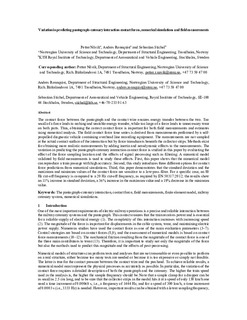| dc.contributor.author | Nåvik, Petter Røe | |
| dc.contributor.author | Rønnquist, Anders | |
| dc.contributor.author | Stichel, Sebastian | |
| dc.date.accessioned | 2017-10-26T07:28:14Z | |
| dc.date.available | 2017-10-26T07:28:14Z | |
| dc.date.created | 2017-05-05T15:51:45Z | |
| dc.date.issued | 2017 | |
| dc.identifier.citation | Vehicle System Dynamics. 2017, 55 (9), 1265-1282. | nb_NO |
| dc.identifier.issn | 0042-3114 | |
| dc.identifier.uri | http://hdl.handle.net/11250/2462244 | |
| dc.description.abstract | The contact force between the pantograph and the contact wire ensures energy transfer between the two. Too small of a force leads to arching and unstable energy transfer, while too large of a force leads to unnecessary wear on both parts. Thus, obtaining the correct contact force is important for both field measurements and estimates using numerical analysis. The field contact force time series is derived from measurements performed by a self-propelled diagnostic vehicle containing overhead line recording equipment. The measurements are not sampled at the actual contact surface of the interaction but by force transducers beneath the collector strips. Methods exist for obtaining more realistic measurements by adding inertia and aerodynamic effects to the measurements. The variation in predicting the pantograph–catenary interaction contact force is studied in this paper by evaluating the effect of the force sampling location and the effects of signal processing such as filtering. A numerical model validated by field measurements is used to study these effects. First, this paper shows that the numerical model can reproduce a train passage with high accuracy. Second, this study introduces three different options for contact force predictions from numerical simulations. Third, this paper demonstrates that the standard deviation and the maximum and minimum values of the contact force are sensitive to a low-pass filter. For a specific case, an 80 Hz cut-off frequency is compared to a 20 Hz cut-off frequency, as required by EN 50317:2012; the results show an 11% increase in standard deviation, a 36% increase in the maximum value and a 19% decrease in the minimum value. | nb_NO |
| dc.language.iso | eng | nb_NO |
| dc.publisher | Taylor & Francis | nb_NO |
| dc.title | Variation in predicting pantograph–catenary interaction contact forces, numerical simulations and field measurements | nb_NO |
| dc.type | Journal article | nb_NO |
| dc.type | Peer reviewed | nb_NO |
| dc.description.version | acceptedVersion | nb_NO |
| dc.source.pagenumber | 1265-1282 | nb_NO |
| dc.source.volume | 55 | nb_NO |
| dc.source.journal | Vehicle System Dynamics | nb_NO |
| dc.source.issue | 9 | nb_NO |
| dc.identifier.doi | 10.1080/00423114.2017.1308523 | |
| dc.identifier.cristin | 1468511 | |
| dc.description.localcode | This is an Accepted Manuscript of an article published by Taylor & Francis in Vehicle System Dynamics on 30 Mar 2017, available online: http://www.tandfonline.com/10.1080/00423114.2017.1308523. Locked until 30 Mar 2018 due to copyright restrictions. | nb_NO |
| cristin.unitcode | 194,64,45,0 | |
| cristin.unitname | Institutt for konstruksjonsteknikk | |
| cristin.ispublished | true | |
| cristin.fulltext | postprint | |
| cristin.qualitycode | 1 | |
